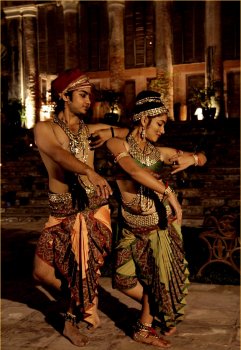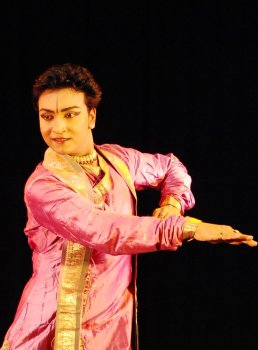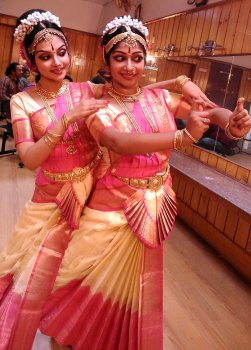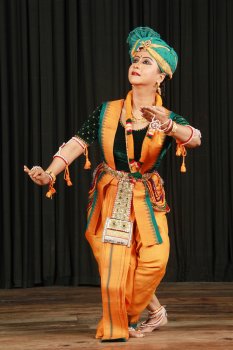
|   |

|   |
Snippets of Uday Shankar Dance Festival - Sulagna Mukhopadhyay e-mail: sulagna64@gmail.com December 29, 2013 A dance festival to mark the birth anniversary of Uday Shankar is organized every year by the State-run West Bengal State Music Academy. This year, the festival was held between 11th and 16th of December. The carnival included classical dances from across the country. On 15th of December there was an array of classical dances presented by both eminent dancers and budding artistes. Brhaddesi by Matanga Muni is a landmark in Sangeetasastra as it acts a as a link between Natya Shastra and Dattilam on one hand and Abhinavabharati on the other. He described the sequences of dance, music and drama in Natya Shastra as Marga. The word symbolizes the reunification of our souls with the cosmic pulsation and simultaneously initiates our ultimate consciousness. Marga Nritta is a researched way of presenting ancient Indian tradition of dance and music, codified in the inscriptions of Natya Shastra by Bharatamuni. The prime focus of Natyashastraic dance tradition was deeply embedded in the basis of Indian philosophy. Through the unified practice of dance, music and percussion, this tradition tried to build the bridge between the Pinda (our gross body) and Brahmanda (the cosmic body of universe). The manifestation of this universe generates through the pulsation of Shakti within the pulse-less body of Shiva. While vibrating, the shakti gradually conglomerates into vindu, and from that point onwards, nada or the primal sound starts to manifest itself into dhvani or subtle manifested sound and jyoti or the illumination. The Natyashastraic dance represents that manifestation of dhvani and jyoti through the spanda or the subtle cosmic pulsation. An alumnus of Kerala Kalamandalam, Kalamandalam Piyal is the artistic director of Marga Nritta. He is involved with his research on Natya Shastra for the past 15years. This day’s presentation included two of his disciples Pinki Mondal and Akash Mallick. The presentation was divided into two parts asarita-vardhamana vidhi and gandhari-kapala geeti. Both were duet presentations. The dancers expressed the cosmic pulsation through serpentine movements and connected themselves with the ultimate consciousness. This pure vision is from Shaiva darshan and manifested in dance through the armature of Tantra. The music-orchestra is very important in case of Natyashastraic performances. Mentioned as Kutap by Bharatamuni, this music-orchestra generates the nada from behind which the dancers express through the spiral movements of their limbs. The Kutap was performed by Pravir Das (sushir vadya or flute player), Arindam Banerjee (singer or gayaka), Debaroti (female singer or gayika), Apoorvalal Manna (panava or kettledrum player), Kalamandalam Piyal (dardur player), Mithun Chakravarty (mridanga player), Sayok (vaipanchik veena or Indian harp player) and Shree Deep (taaldharak or keeper of the rhythm). The costumes of both the dancers and the musicians were according to the description given by Bharatmuni. The entire production was successful in bringing out the quintessential elements of the Natyasastra. The microphones were a constant pain throughout the performance.  Pinki Mondal and Akash Mallick  Rudrava Niyogi Soumalini Sengupta and Dipan Maitra were both interested in dance at a very tender age. For the last 15 years, they have been grooming and nourishing their dancing skill, under the guidance of Anita Mallick. The duo presented three Bharatanatyam items. The first one was a Mallari set in ragam Gambheera Nattai and talam tisra triputa. A Mallari was traditionally performed while the deity was carried around the temple in festive procession. Mallaris are usually set to catchy tunes and has interesting rhythm patterns. There is no sahityam involved and the composition is a pure rhythmic one. This was followed by a kirtanam set in Ragamalika and talam adi. Not only Radha, but the entire Brindavan is spellbound under the magical spell of Krishna’s boundless love. Each and every lady of Gokul nurtures in her heart the thought of Krishna as her lover. The enchanting tune of this shepherd boy’s flute hypnotizes the cattle in the field and they refrain from grazing. The birds and other animals are also not free from the captivating melodious appeal. The concluding item was a thillana set in ragam Natabhairavi and talam adi. In every item the patterns of movement was in perfect sync with the lyrics. The amazing team spirit of the dancers and their concentration on delectably diverse formations in sharp light and shade effects twinkled in electronic precision of movements.  Soumalini Sengupta and Dipan Maitra  Bimbavati Devi Eminent Manipuri dancer Bimbavati Devi began her recital with Madhuran Nartan. It is based on the lasya style of Manipuri dance. It began with an invocation to Lord Krishna. Surrounded by his herd of cows and beautiful maidens, he stands underneath the kalpa-vriksha, adorned in divinely beautiful ornaments. The bhakta says, “You show me the path to salvation, my Lord, I surrender myself at your lotus feet.” After this invocation, the dancer moves on to describing the graceful gait and dance of Krishna. He is surrounded by gopis in the way the moon is encircled by stars in the night sky. The music is composed by Guru Kalavati Devi, assisted by Srijan Chatterjee and part of the music is traditionally sung in rasaleelas. Vocal support was by Romila Devi and pung accompaniment by Brojen Singh. The second piece was Kaliya Daman. This abhinaya piece was based on the popular story of Lord Krishna subjugating the venomous Kaliya Nag who had infested the waters of river Yamuna. Dance and music was composed by the legendary maestro, Guru Bipin Singh. Vocal support was by Draupadi Devi and pung accompaniment by Guru Birmangal Singh. Mridu Uddhata Krishna Nartan was pure dance, a choreography of Guru Bipin Singh. It described the soft or mridu and the vigorous or the uddhata aspects of Manipuri dance. The movements of this dance are inspired from the pung cholom and kartal cholom of Manipuri Nata Sankirtana. Vocal support was by Draupadi Devi and pung accompaniment by Guru Birmangal Singh. The gestural delicacy and vivacity of the interplay sometimes yielded to moments of virtuosity. The performance brought out the rich diversity of the dance form and was warmly received by an enthusiastic Kolkata audience. Sulagna Mukhopadhyay was trained in Bharatanatyam by Guru Thankamani Kutty and Indian folk by Late Botu Pal. She has an M.A. in Comparative Literature and has freelanced for various leading newspapers of Kolkata like The Telegraph, The Statesman and Ananda Bazar Patrika. She has written articles on dance and gender issues. She is a teacher of South Point School since 1996. |